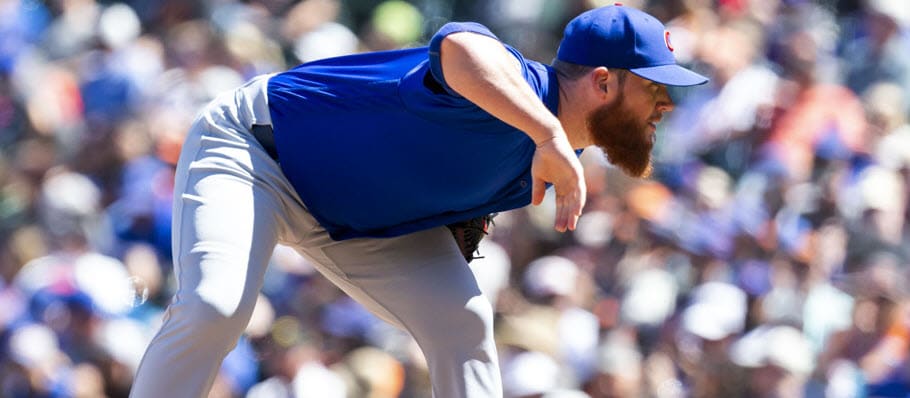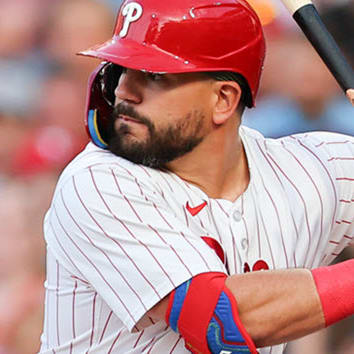This article is part of our Collette Calls series.
This article is part of our Collette Calls series.
Recall the premise of this annual series of bold predictions stated in the first installment:
It's time, once again, to put myself out there and make 60 predictions for the new season. The premise for this annual article series remains the same: the prediction has to be somewhat grounded in reality but at the same time viewed as unlikely when you first read it. So, you will not find me predicting Ryan Yarbrough to win the Cy Young, but you may see me making calls predicting a breakout for Corbin Burnes as I did in this series just last year. Conversely, you will find some big misses such as me laying out the case why Shane Bieber would not finish the season as a top-20 starting pitcher.
When you play in the margins with predictions, you are going to lose more than you will win. The last three seasons, I've hit on 21 to 24 of the 60 predictions I've made with some rather big hits (Renato Nunez, Blake Snell, Lance Lynn, Jose Abreu) and many more misses. Just last year, this series helped identify the upside of taking a chance on A.J. Pollock, Andrew McCutchen, Asdrubal Cabrera, Ian Happ, Marcell Ozuna, Trent Grisham, Chris Bassitt, the aforementioned Burnes, Tony Gonsolin, and Justus Sheffield.
While I strive for higher rates of accuracy, you will not see
This article is part of our Collette Calls series.
Recall the premise of this annual series of bold predictions stated in the first installment:
It's time, once again, to put myself out there and make 60 predictions for the new season. The premise for this annual article series remains the same: the prediction has to be somewhat grounded in reality but at the same time viewed as unlikely when you first read it. So, you will not find me predicting Ryan Yarbrough to win the Cy Young, but you may see me making calls predicting a breakout for Corbin Burnes as I did in this series just last year. Conversely, you will find some big misses such as me laying out the case why Shane Bieber would not finish the season as a top-20 starting pitcher.
When you play in the margins with predictions, you are going to lose more than you will win. The last three seasons, I've hit on 21 to 24 of the 60 predictions I've made with some rather big hits (Renato Nunez, Blake Snell, Lance Lynn, Jose Abreu) and many more misses. Just last year, this series helped identify the upside of taking a chance on A.J. Pollock, Andrew McCutchen, Asdrubal Cabrera, Ian Happ, Marcell Ozuna, Trent Grisham, Chris Bassitt, the aforementioned Burnes, Tony Gonsolin, and Justus Sheffield.
While I strive for higher rates of accuracy, you will not see me lower the credentials for predictions to increase the chances of the prediction coming true. My goal is not to go 60 for 60 on these; it is to get you thinking differently about each one of these players. Statistical predictions in player capsules or writeups are, at best, within the range of accuracy 70 percent of the time. My purpose is to get you thinking about what could potentially happen in the other 30 percent of the pie.
The small sample of 2020 compounded with all of the related factors in prepping for and playing through a season during a pandemic loom large in the statistics, which is why you'll see a focus on timelines rather than solely focusing on the previous season.
All ADP is from the last 60 days from 123 NFBC drafts.
Chicago
Nico Hoerner (ADP 435; high 314, low 550) is a top-25 second baseman/shortstop. Hoerner is the 41st second baseman off the board or the 38th shortstop, as he has dual eligibility up the middle with likely another position or two to be added in-season. It is a given Hoerner will hit down the lineup with all the talent in front of him, but that should not diminish his value as he should be in the lineup everyday, even though there will be times it will not be at second base.
Hoerner is a 2018 first-round infield selection who has some Joe Panik feel to him — both first-round infield selections light on power but with a track record of hitting for average. Hoerner hit .303/.351/.408 in three years at Stanford with the classic inside-out "Stanford Swing." The Cubs have worked on changing the swing in his minor league development, and Hoerner hit .297/.365/.427 in 89 games before making it to the majors where he has hit .247/.309/.333 in more than 200 plate appearances. His .312 OBP in 2020 was completely propped up by his 10 percent walk rate as he hit .222 in 48 games.
Hoerner has above-average bat-to-ball skills and 93rd percentile sprint speed and has shown an ability to accept walks as well. The Cubs, on paper, have plenty of offense assuming Javier Baez and Kris Bryant put 2020's issues behind them. Hoerner's defense keeps him in the lineup and he has the abilities to get on base and utilize his speed. Bold upside projection is 10-15 steals, a .280 average and 60-plus runs and RBIs if the lineup is firing on all cylinders.
Craig Kimbrel (ADP 200; high 122, low 357) is a top-8 closer. Kimbrel is currently the 16th closer off the board just behind Rafael Montero and just ahead of Kirby Yates. This has been quite the fall from grace for the former elite closer since signing a three-year deal for $43M with the Cubs. He is 0-5 with a 6.00 ERA and a 1.53 WHIP in his two seasons in Chicago while going 15 for 19 in his saves chances. Do not quit on him just yet.
He began 2020 in the worst of fashions, allowing 12 baserunners and seven earned runs in just 2.2 innings, leading most to think he was done. Kimbrel lost the full-time closer role to Jeremy Jeffress last season, but finished the season allowing 11 baserunners and striking out 26 batters in his final 12.2 innings. Kimbrel may not be a top-3 elite closer, but he still has very good stuff when he is on his game. He has 93rd percentile velocity, and despite the struggles last season, the league hit .206 off his fastball and .143 off his curveball. The troubles for Kimbrel come when he cannot locate his fastball and just walks hitters or falls into predictable counts that led to the league hitting .326 off his fastball in 2019. There is a delicate balance when facing Kimbrel; take until he throws strikes, or be aggressive early to avoid the curveball. Most recently, the league has chosen the former:
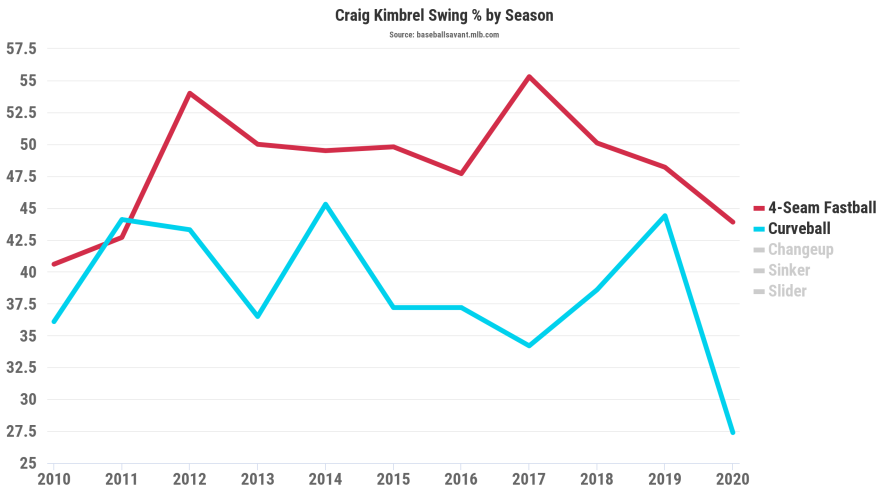
Kimbrel cannot live on fastball alone and has mostly been at his best when he can entice hitters to expand their zones. 2020 saw hitters spitting on the highest frequency of his pitches in recent years, but particularly on the curveball as they also refused to chase it out of the zone:
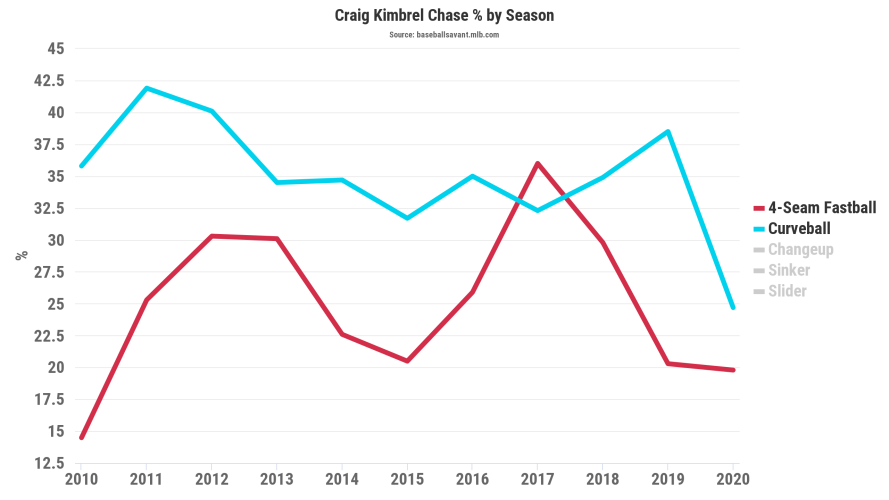
When he had to come in the zone as 2020 went on and he got his pitching legs under him, the league was once again struggling to make contact with both pitches:
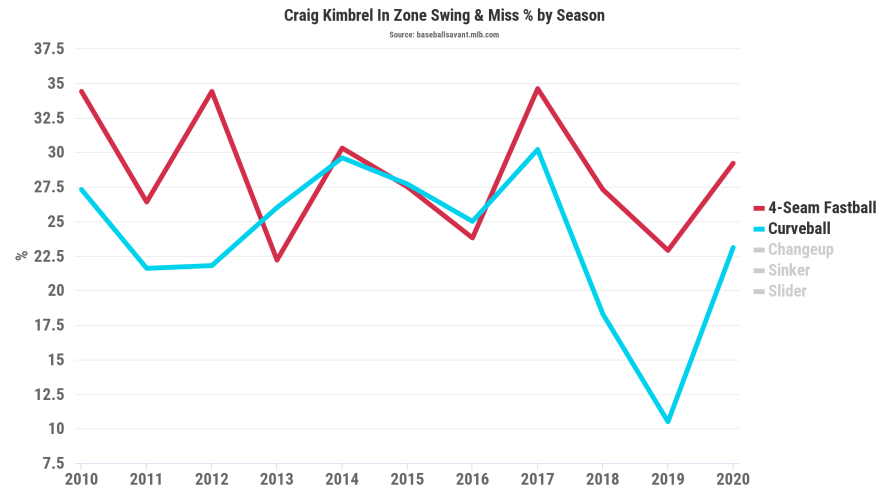
There is enough here to give Kimbrel one more chance, and his current market price is almost begging for it. He, and you, will live and die by his command. The walks will be a problem, but he can offset some of that if he can continue his elite level strikeout rates, which have been a trademark of his career.
Cincinnati
Aristides Aquino (ADP 567; high 420, low 724) is a top-100 outfielder. "The Punisher" is the 130th outfielder off the board, about 180 picks later than current OF100, Hunter Renfroe at pick 386. Aquino has experienced the highs of hitting 47 homers between Triple-A and the majors in 2019, and the lows of a miserable 2020 season. Aquino can hit light-tower home runs but has plenty of flaws as a hitter, most notably a struggle to make contact at the big league level, albeit through 80 games. What he does have going for him in 2021 is that he is out of minor league options, and he is not the type of hitter a club really wants to carry on the bench.
This bold prediction is predicated on the fact Aquino is likely to be traded or exposed to waivers, where he will certainly be acquired by a lesser club and given the chance to see if his skills are worth holding onto. In a dream world, he ends up in Baltimore and follows the similar path Renato Nunez blazed for him the last couple years after Oakland could no longer keep him on the roster. In a full-time role in the right setting, Aquino has as much of a chance at 30 homers as he does hitting .230 in a full season. He is not exactly a slog on the basepaths either, so 10-plus steals is a possibility as well. This prediction has the likelihood of being a huge miss, like many of Aquino's swings, but the talent is going to get a chance to play. Stuff like what he did in 2019 is not just a flash in the pan. He has a stance like Tony Batista and has the abilities to put up some similar stat lines at the highest end of the probability scale:
Tejay Antone (ADP 323; high 258, low 400) is a top-100 pitcher. Antone is the 126th pitcher off the board as he, along with Amir Garrett, and Lucas Sims have all been named as possibilities to close for the Reds in 2021 with the departure of Raisel Iglesias. Antone has the highest ADP of the trio, which are tightly packed between picks 323 and 335 as the 126th to the 130th pitcher off the board. One of these guys should win the primary job and separate from the pack, and Garrett has the curse of currently being the only lefty in the projected bullpen, potentially giving Antone and Sims the arm up. Sims is a converted starter who has seen a spike in his dominance since moving to the bullpen while Antone has been a full-time starter throughout his career until moving into the bullpen in his rookie season in the majors.
Antone throws his sinker and slider equally as much as both pitches have a high amount of spin and whiffiness to them. The league hit .146 off the slider with a 47 percent Whiff%, and Antone also used his curve and changeup to generate Whiff%'s higher than 30 percent last season. My affection for Antone comes from the fact he is not going to be the typical one-inning reliever as his development as a starter shows he is capable of doing some multi-inning relief work whether he is closing a game or not. Between he and Sims, Antone has the higher groundball rate, which should also work in his favor for the closer role.
Milwaukee
Avisail Garcia (ADP 330; high 227, low 459) is a top-60 outfielder. Garcia is currently the 85th outfielder off the board, going just after Jo Adell and just before Willie Calhoun. Garcia turns 30 this season and is playing in the final guaranteed year of his contract as the club holds the $12M option for the 2022 season with a $2M buyout. Simply put, he is a motivated man coming off a disappointing 2020 season by his standards.
Garcia posted a career-high walk rate but struggled to hit with his usual thump at the plate, and I attribute it do him moving from right field to center field once Lorenzo Cain opted out of the season within the first week. Center field is taxing when you prepare for it, more so when it is thrust upon you as it was for Garcia, as he started at the position in 42 of the 60 games last season. Garcia had a career-worst statistics across the StatCast board, save the walk rate. Perhaps he was just too tired to swing the bat and decided accepting the walk was the easiest way forward.
Garcia owns top 25th percentile speed, so the 10 steals in 2019 are not a fluke even though it remains the only season of his career in which he has achieved double-digit steals. Garcia has built a career around hard contact, but that evaporated last year in his struggles:
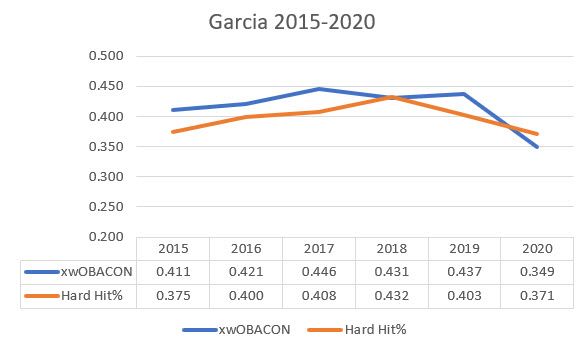
Garcia moves back to a corner outfield position in 2021 with Cain back on the roster, and should be ready to take advantage of the run environment Milwaukee offers with less defensive stress on his mind and legs. Another 20/10 season is certainly attainable with potentially more with a full-time role his for the taking.
Josh Lindblom (ADP 350; high 202, low 530) is a top-100 pitcher. Lindblom is the 133rd pitcher off the board, going just after Tejay Antone and just before Adbert Alzolay. Lindblom pitched to "The Facts of Life" lyrics: you take the good (strikeouts), you take the bad (ERA), you take them both and there you have the facts of owning Lindblom life. He struck out 27 percent of the hitters he faced and had a decent 1.28 WHIP while holding hitters to a .244 average, but the 1.2 HR/9 rate and an inability to strand runners led to a 5.16 ERA (3.88 FIP).
Lindblom owns both a high spin fastball (94th percentile) and a high spin curve (78th percentile) but lacks velocity (7th percentile), yet has an above-average swing-and-miss rate as well as strikeout rate. StatCast gives him six pitch classifications, and Lindblom threw all six to both righties and lefties with different levels of frequency. He has only terribly lucky with his curveball, but in a 75-pitch sample size, you cannot put too much weight into that. All six pitches had a swing-and-miss rate above 20 percent, which is damn near impossible to pull off. He deserved better, and with Cain going back to hawk balls in center field, he should have better fortunes this season.
Pittsburgh
Bryan Reynolds (ADP 289; high 218, low 369) is a top-60 outfielder. Reynolds is the 80th outfielder off the board going just after Aaron Hicks and just before Scott Kingery. Reynolds had an incredibly disappointing sophomore campaign after his solid showing as a rookie, but we should not discard him in 2021. After all, someone has to hit cleanup on this team, and it appears that Reynolds will be that guy. Hitting in the fourth spot of the lineup pretty much locks in 75 RBIs on the low end of things just based on quantity of at-bats. Reynolds will play everyday as long as his body allows, and 2020 was the first season in which he failed to hit at least .300 as a professional baseball player.
Reynolds may struggle to repeat the 16 homers he hit in 2019, but hitting for average is another way to drive in runs, lest we forget the list of players who has driven in at least 80 runs with fewer than 16 home runs in recent seasons:
- Colin Moran (2019) - 80 RBIs, 13 homers
- Yuli Gurriel (2018) - 85 RBIs, 13 homers
- Nick Markakis (2018) 93 RBIs, 14 homers
- Josh Reddick (2017) 82 RBIs, 13 homers)
- Melky Cabrera (2016) 86 RBIs, 14 homers)
- Brandon Crawford (2016) 84 RBIs, 12 homers)
- Nick Markakis (2016) 89 RBIs, 13 homers)
Nick Markakis is a great comp. Markakis hit second or fifth in the 2016 Atlanta lineup, but spent most of the 2018 season hitting cleanup for Atlanta. Admittedly, Markakis had Ender Inciarte, Ozzie Albies and Freddie Freeman hitting in front of him and nobody on the Pittsburgh roster can hold a candle to those three, but this prediction is based on opportunity. Players will be on base in front of Reynolds and he has a proven ability to hit for average to drive them in. He won't excel in any one area, but darn it, he will compile in runs, RBIs and homers while producing a solid batting average.
Steven Brault (ADP 513; high 344, low 627) is a top-150 pitcher. Brault is the 197th pitcher off the board, going just after super-Twitcher Trevor May and just before the fireballing Garrett Crochet. I'm also making this prediction based on input from my good friend Ian Kahn. I had Miguel Yajure slotted for this pick, but Ian encouraged me to take another look at Brault and I am buying what Kahn is putting down.
Recall with some of the earlier bold predictions in this series that I believe there is a market inefficiency in looking at contact suppressing pitchers, and Brault falls into that category. None of his stuff jumps off the page, but in 2020, he was in the top 20th percentile in limiting barrels and top 25th percentile in limiting hard contact. Better yet, he was in the 89th percentile in exit velocity.
Brault throws fives pitches and has thrown all five pitch types to both righties and lefties. The league hit below .150 off both his primary pitches — the fastball (.149; .203 xBA) and the changeup (.152; .183 xBA) as he added a little more spin to his fastball and shelved his cutter from 2019 while ramping up his changeup usage. None of his pitches jump off the chart at you, but his ability to throw multiple pitches to both righties and lefties helps keep them off balance a bit. It would be great if he could reduce his double-digit walk rate, but it appears to be a product of him refusing to give into certain hitters, while attacking others worked for him in 2020. He has improved his strikeout rate each of the last four seasons but has yet to post a double-digit K-BB%. 2021 may be the first year he does that while pitching for arguably the worst team in the majors.
St. Louis
Dylan Carlson (ADP 148; high 106, low 231) finishes as a top-100 overall player. Carlson was the guy everyone chased heading into the season as the next hot stock, but the return on investment was disappointing. The NFBC market has not exactly cooled on him, but Carlson has the abilities to have a breakout season and push his way into the top 100 by season's end.
Carlson is projected to hit in the middle of the lineup, which should provide ample RBI opportunities with Paul Goldschmidt and Nolan Arenado reaching base in front of him. It would not be surprising to see the league initially pitch around the veterans to force the issue with the sophomore and see what adjustments he makes from 2020. His rolling graph last year shows he was getting it as the season went on:
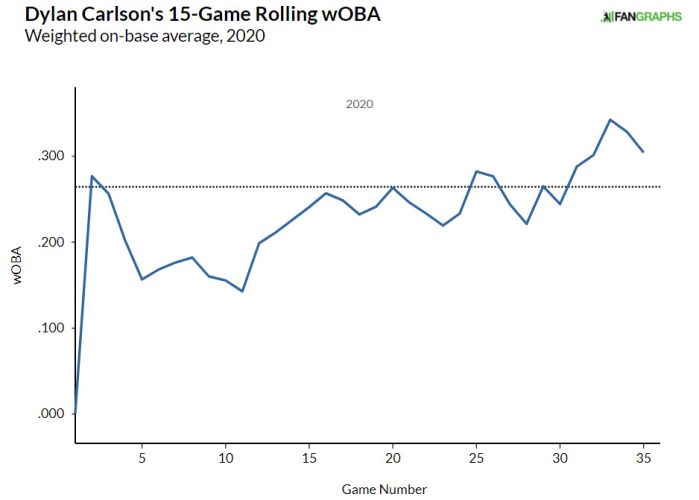
Yes, he spent most of the season below the league average (dotted line), but the trend shows forward progress as the season went on and that is what is more important than the final overall numbers in a lost season. Twenty homers, 70-plus runs, 70-plus RBIs and 10-plus steals are all attainable numbers for Carlson's abilities, and I expect this will be the last season he is drafted outside the top 100 for the foreseeable future.
Alex Reyes (ADP 401; high 221, low 554) is a top-120 pitcher. Reyes is the 151st pitcher off the board, sandwiched between Miles Mikolas and Hunter Harvey. Reyes came up in 2016 and wowed us with his abilities, but has mostly been baseball's version of Halley's comet having since pitched 26.2 innings the last four seasons due to an absurd amount of injuries. Reyes has spent 369 lifetime days on the injured list with 245 of those related to his elbow troubles.
Reyes returned last season to strike out 27 hitters and allow 14 hits in 19.2 innings and was throwing with the fastball velocity last seen from him in his rookie season. The league hit .156 off the reinvigorated fastball with a 27 percent Whiff%, and his breaking balls had plenty of whiffiness to them as well. Reyes throws five pitches, and while he has the repertoire of a starting pitcher, he certainly does not have the body of one. Yet, Cards GM John Mozeliak has said Reyes is coming to camp on a starter's program.
My bold prediction is premised on the fact they are in fact using that program to prepare Reyes for a multi-inning relief role where he will be in line for some relief wins with the potential of a high strikeout total for a relief pitcher. Nick Anderson, Matt Barnes, Josh James and Seth Lugo are recent relievers to enjoy 100-plus strikeout seasons while allowing other pitchers to be the primary closer. Each won five or more games and saved at least one game in 2019 as well and Reyes should be in position to replicate that level of success for a non-closer assuming his body does not fail him again.

